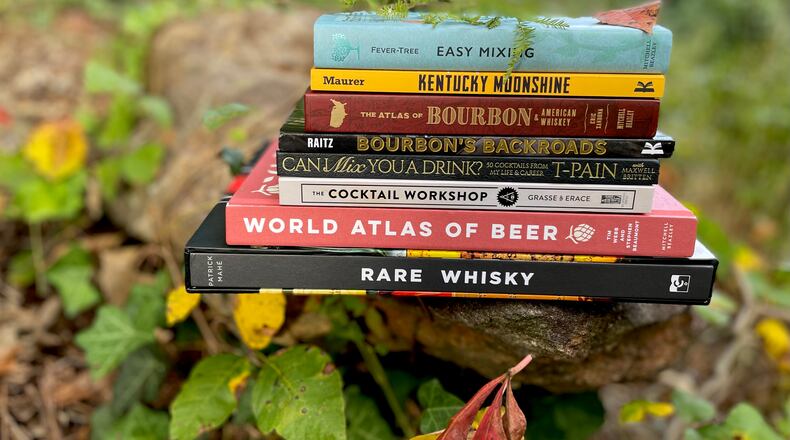It’s been a great year for drink writing. This season’s crop of new drink books is as enchanting and diverse as the leaves beginning to fall from trees. From recipe guidebooks to the backroads of moonshine and whiskey to an authoritative compendium that already feels like a classic, there is a spirited title for everyone’s boozy bookshelf.
Here are a dozen notable tomes to keep you reading and perhaps stirring through the fall and beyond. Dates indicate books that will be released in the coming weeks.
Grow your knowledge as you move through each drink in these new cocktail manuals. Twenty classic drinks lay the foundation for Steven Grasse and Adam Erace’s “The Cocktail Workshop” (Running Press, $27.50, Nov. 2). Each is its own chapter with classic recipe, riffs with substitutions, extra elements or multiple modifiers and a “workshop” that presents a technique to learn. Take a Manhattan to a Rob Roy to a Tipperary and learn how to make your own bourbon cherries in easy, straightforward conversational style. Using the premium mixer brand based on high-quality, natural ingredients, “Fever-Tree Easy Mixing” (Mitchell Beazley, $19.99) offers 150 cocktail recipes — from gin and tonic variations to New World highballs with whiskey to no- and low-alcohol drinks. Each recipe can be made in no more than three minutes and offers variations to go the speedy way or to amp it up and experiment “with a twist.”
Grammy Award-winning artist T-Pain (with Maxwell Britten) blends music making and drink making in “Can I Mix You a Drink?” (Kingston Imperial, $29.99, Nov. 2). It all started when he found a glass with a gold inscription reading “I’m Fancy” at an Atlanta boutique. Now he can drink the fancy drinks from the slick black pages. His exploration of new flavors to create unconventional recipes includes “Dranks” such as All I Do Is Win, Shawty, Red Cup and the brightly hued Neon Lights.
From the author of “The Bourbon Bible,” “The Atlas of Bourbon & American Whiskey” (Mitchell Beazley, $19.99) is a guide by states and regions. Eric Zandona gives an overview on how the creation of whiskey is informed by the grains, water and climate of the area where it is made from Kentucky bourbon heartland to American single malts of the Pacific Northwest. The compact tome is richly illustrated with maps, statistics and snapshots of notable distilleries.
For the whiskey lover who also loves history, facts and figures, professor Karl Raitz examines the landscape and heritage of Kentucky’s signature spirit in “Bourbon’s Backroads” (University Press of Kentucky, $19.99). From 18th-century pioneers to a close examination of distilleries and their landscapes, the scholarly read illuminates the ins and outs of distilling. Lawful and illicit branches of the industry grew side by side in Kentucky. David Maurer proves that nothing stimulates enterprise as much as to prohibit the activity in his historical yet whimsical book “Kentucky Moonshine” (University of Kentucky Press, $17.95). From the whiskey rebellion, across the Ohio River, to fertile Kentucky, he explores the genesis, production and geography of moonshine.
Ever wonder what to get the whisky collector whose taste is rare and expensive? Patrick Mahé's “Rare Whisky” (Conran, $55, Oct. 19) is as exquisite as the rarities he details within. It’s a coffee-table hardback with stunning photography that comes in a slipcase.
Credit: Handout
Credit: Handout
Who better to co-edit (with writer Noah Rothbaum) the hefty, highly researched, extra deep dive “The Oxford Companion to Spirits & Cocktails” (Oxford University Press, $65, Nov. 4) than drink historian David Wondrich? With 1,150 entries on the history and global culture of consumption, you’ll look something up, go to a cross-reference and end up somewhere completely different, learning origin stories, recipes and biographies of how spirits are mixed into potions. From absinthe to falca to Gary Regan through pages of whiskey to Zubrowka, it’s a definitive work on imbibing.
Credit: Handout
Credit: Handout
In “The Way of the Cocktail” (Clarkson Potter, $32, Nov. 9), Julia Momośe (with Emma Janzen) takes us behind her bar and into the realm of Japanese cocktail culture. With gorgeous photography and illustrations, recipes have a seasonal approach to presentation, based on the 24 micro seasons of Japan’s calendar.
Credit: Handout
Credit: Handout
Delve into the world of bubbly in Zachary Sussman’s “Sparkling Wine for Modern Times” (Ten Speed Press, $19.99, Nov. 16), where he explains the basics, debunks myths and introduces you to producers to know. Illustrator Nick Hensley really brings it to life with dazzling illustrated charts and timelines. From the hazy bottle of pét nat, to the easy-drinking but difficult-to-pronounce txakoli, he familiarizes the reader with fizz.
Credit: Handout
Credit: Handout
For the Mennonite curious drinker, “Menno-Nightcaps: Cocktails Inspired by That Odd Ethno-Religious Group You Keep Mistaking for the Amish, Quakers or Mormons” (Touchwood, $22) is a satirical read and mixology guide by S.L. Klassen. Seventy-seven recipes, presented with comical illustrations, are as informative as they are hilarious. Mix up a Rum-Springa or a Thumbscrew Driver, named for the 16th-century historical instrument of torture. Easily convert many to Sunday School Sippers by omitting alcohol. You’ll be clinking glasses with “To the Peacemakers!” in no time.
With maps of crucial trends, a myriad of beer styles, brewing techniques and changes, Stephen Beaumont and Tim Webb lay out what is happening in the world of beer today in “World Atlas of Beer” (Mitchell Beazley, $39.99, Nov. 2). They organize beers past, present and future country by country, from the long sea journey of the original IPA in 1780 to where to find brewpubs in Tanzania, spotlighting important beers within the category.
Read more stories like this by liking Atlanta Restaurant Scene on Facebook, following @ATLDiningNews on Twitter and @ajcdining on Instagram.
About the Author
The Latest
Featured






